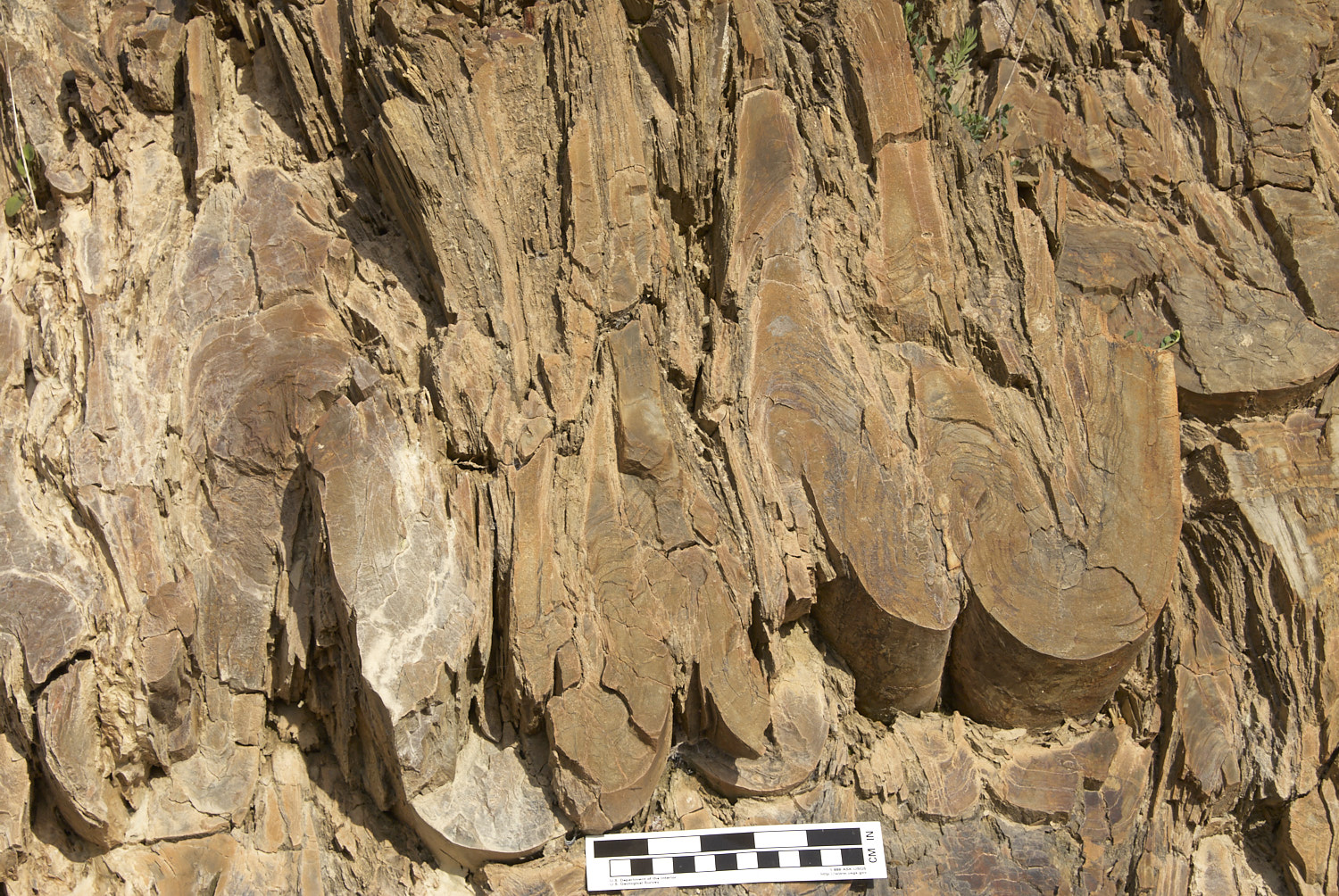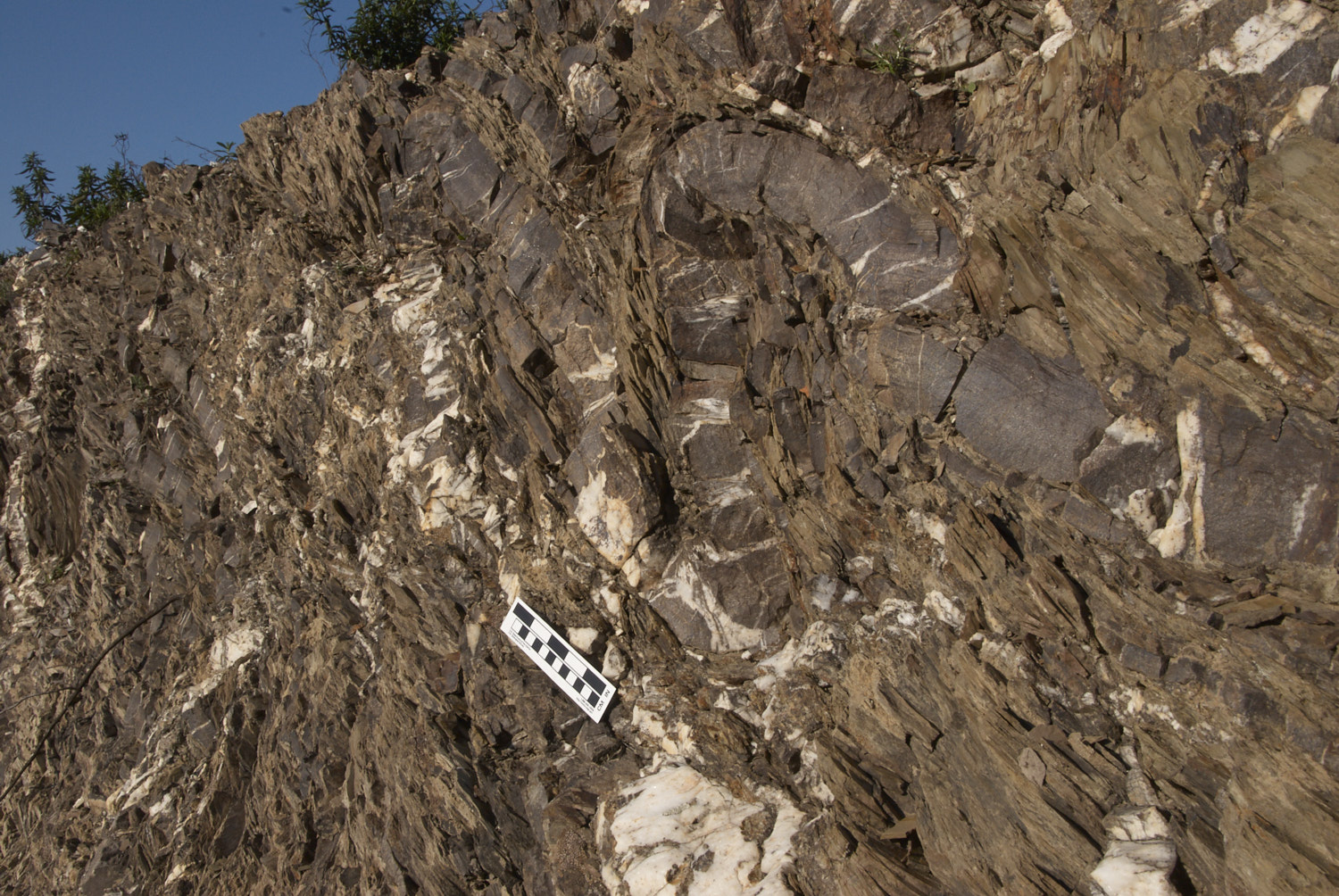justificação do valor científico
Geological section using the municipal road connecting Salgueiros to Pomarão and through the old railway to the São Domingos mine. The section exposes (1) the western sector of the Pomarão-Puebla de Gusman-Tharsis antiform, including the normal limb (to the north) and the core of the antiform, occupied by Phyllite-Quartzite (PQ) Group rocks, and (2) the inverse limb of the structure, towards the south. The rocks of the Mértola Formation, the Volcanic-Sedimentary (VS) Complex and the PQ Complex are well exposed and easily accessible. There occur many outcrops with sedimentary and volcanic-sedimentary sequences. There are a few fossiliferous outcrops with Posidonia Becheri (Upper Visean) of the Mértola formation (Oliveira e Matos 2004).
The Pomarão section is considered the best in the southern Iberian Pyrite (Boogaard, 1967, Carvalho et al., 1976, Oliveira e Silva, 1990, Silva et al., 1997, Oliveira et al., 1998, Oliveira e Matos 2004, Oliveira et al. 2006). According to Oliveira et al., from base to top outcrop successively (1) phyllites and quartzites of the Eira do Garcia member, (2) dark phyllites with intervening nodules and metric lenticular beds of carbonatic rocks of the Nascedios member, together constituting the PQ Complex, (3) the VS Complex follows, with three episodes of felsic volcanism, predominantly rhyolithic, diabases and microdiorites at its base. The igneous rocks are separated by a variety of shales/phyllites, siltites and quartzwackes, with black shales at the base and more siliceous ones in the upper domains. Among sediments, the Varjotas member and the Purple Shales (Xistos Borra de Vinho) are particularly noteworthy, the former in view of its uncommon iron and manganese nodules, and the latter because they constitute an excellent stratigraphic marker. In spite of thorough investigations, only the upper part of the Nascedios Formation could be dated, with Fammenian conodont fossils (Boogaard, 1967, Schermerhorn, 1971) and remnants of Clymeniida, brachiopds and trilobites of the same age. The shales contain spores of biozone LL, which indicate a middle Strunian age (Oliveira et al. 2005).
Pomarão is is a geosite of international value in view of the continuity of the geological sequences. There is a geological trail defined through the geosite, since 2005, produced by LNEG (former INETI), the Mértola Municipality, and CCDR Alentejo.
References:
Boogaard, M.V. Den, Schermerhorn, L.J.G. (1981) - Conodont faunas from Portugal and southwestern Spain. Part 6 - a lower Famennian conodont fauna at Monte Forno da Cal (South Portugal) Scrip. Geol. 63:1.16.
Carvalho, D., Conde, L., Enrile, J., Oliveira, V., Schermerhorn, L., Palomero, F., Caballero, E., Madel, J., Martín, E. (1976) – III Reunião de Geologia do SW do Maciço Hispérico da Península Ibérica, Huelva-Beja, 1975. Liv. Guia das excursões geológicas na FPI. Com. SGP t. 60, pp. 271-315.
Oliveira, J.T., Silva, J.B. (1990) – Carta Geológica de Mértola Fl. 46D na escala 1/50000, SGP.
Oliveira, J.T., Silva, J.B., Oliveira, V., Munhá, J., Matos, J.X. (1998) – Geologia da região Mértola, Pomarão e Mina de São Domingos. V Cong. Nac. Geol., IGM, pp.101-110.
Oliveira, J.T., Matos, J.X. (2004) O caminho de ferro da Mina de S. Domingos ao Pomarão: um percurso geo-educacional na Faixa Piritosa Ibérica. XXIV Encontro Prof. Geociências APG, 19pp.
Oliveira, J.T., Pereira, Z., Rosa, C.J., Rosa, D., Matos, J.X. (2005) Recent advances in the study of the stratigraphy and the magmatism of the Iberian Pyrite Belt, Portugal. In: Carosi, R., Dias, R., Iacopini, D., Rosenbaum, G., (Eds.,). The southern Variscan belt, Journal of the Virtual Explorer, Electronic Edition 19/9, 1441-8142.
Oliveira, J.T., Relvas, J.M.R.S., Pereira, Z., Matos, J.X., Rosa, C.J., Rosa, D., Munhá, J.M., Jorge, R.C.G.S., Pinto, A.M.M. (2006) O Complexo Vulcano-Sedimentar da Faixa Piritosa: estratigrafia, vulcanismo, mineralizações associadas e evolução tectonoestratigráfica no contexto da Zona Sul Portugesa. in Dias R, Araújo A., Terrinha P, e Kulberg JC ( eds.), Geologia de Portugal na Ibéria, VII Cong. Nac. Geologia, Univ. Évora, Portugal, pp. 207-244.
Rego, M. (2004) Mina de S. Domingos 150 anos de História. Fotogramas da memória. CM Mértola, 85pp.
Silva JMB, V Oliveira, J Matos, JC Leitão, 1997. Field Trip #2: Aljustrel and the Central Iberian Pyrite Belt. In Barriga FJAS, Carvalho D, eds, 1997. Geology and VMS Deposits of the Iberian Pyrite Belt, Society of Economic Geologists Guidebook Series, Boulder, Colorado, USA, vol 27, 192 p
Outros valores e sua justificação
Interesting landscape value associated to the Guadiana and Chanca river valleys.
The remnants of the Pomarão river harbour lie in the end of the geological/mining trail between the São Domingos open pit and the Guadiana river. Part of the trail is through the ancient mine railway, one of the earliest in the country.

